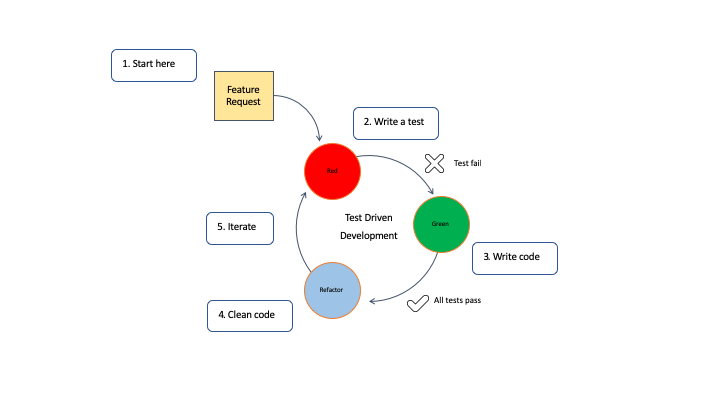What is Test-Driven Development (TDD)
Test-Driven Development (TDD) is a software development methodology that emphasizes writing tests before writing the actual code. The primary goal of TDD is to ensure that the code meets the requirements and is free of defects. It is based on the idea that if you have a comprehensive suite of tests, you can have more confidence in the quality of your code, leading to fewer bugs, easier maintenance, and faster development cycles.
TDD is an iterative approach that follows a simple cycle: write a test, make it pass, and refactor the code. This cycle is repeated until the desired functionality is achieved, and the tests are used to validate that the code meets the requirements.
Benefits of TDD
There are several benefits to adopting TDD, including:
-
Improved Code Quality
Writing tests before implementing the code ensures that the code is correct and meets the requirements. This results in fewer defects and a more stable product. -
Faster Development
By catching errors early in the development process, TDD allows developers to fix issues more quickly, leading to shorter development cycles. -
Easier Maintenance
The comprehensive test suite acts as documentation for the code, making it easier for developers to understand the codebase and make changes without introducing new defects. -
Better Collaboration
The test suite serves as a common ground for developers, QA teams, and other stakeholders, ensuring that everyone is on the same page about the expected functionality and behavior of the code.
TDD and Agile Development
TDD is a natural fit for Agile development methodologies, such as Scrum or Kanban. Agile teams prioritize working software and adapt to changing requirements, making TDD an excellent tool for ensuring that the code remains stable and functional as changes are made.
In Agile environments, TDD encourages communication and collaboration between team members. Developers and testers can work together to create and maintain the test suite, ensuring that everyone has a shared understanding of the code's functionality and requirements.
TDD also supports CI/CD practices, which are essential for Agile teams. By maintaining a comprehensive test suite, teams can quickly identify and fix issues as they arise, allowing for faster, more reliable deployment of new features and improvements.
Red-Green-Refactor Cycle
The core workflow of TDD is often referred to as the "Red-Green-Refactor" cycle. This cycle represents the three phases of TDD and provides a structured approach to developing new features and fixing bugs. The cycle consists of the following steps:

5 steps of test-driven development
-
Red Phase
Write a failing test (representing the "red" status in the test suite). This test should clearly define the expected behavior or functionality that the code should provide. -
Green Phase
Write the minimum amount of code to make the failing test pass (turning the test "green"). This step focuses on achieving the desired functionality, even if the code is not optimized or elegant. -
Refactor Phase
Improve the code's design, readability, and performance without changing its behavior. The test suite should still pass after the refactoring, ensuring that the code's functionality remains consistent.
This cycle is repeated for each new feature or bug fix, resulting in a test suite that covers all aspects of the code and provides confidence in its correctness and reliability.
References